Well our busy season is upon us and we're excited about the plants we're sending. We have several new pond plants this year. A couple new lotus, waterlilies and bog plants. Check them out at our store, www.dragonflyaquatics.com.
I often get questions about whether to use water lettuce or water hyacinths as floaters in the pond. They both basically serve the same purpose.
Water lettuce (Pistia stratiotes) has light green spongy leaves that looked as if they have veins running through them. The leaves are approximately 1-5" wide. The leaves are covered with tiny hairs and occasionally tiny white flowers appear in the center. Water lettuce prefers partial shade during the hotest part of the day and once the water warms up will multiply quickly. Their dangling roots provide a place for fish to hid. Water lettuce can be very aggressive and can deplete the oxygen in the water if you let it take over your entire pond. So its a good idea to take out some if they start to multiply rapidly. Water temperature should be 60 - 65 degrees before placing water lettuce in your pond as it will turn the leaves white and they will die.
Water Hyacinth - Eichornia crassipes) A floating plant that is a fast grower and beneficial for water filtration. They have bright green rounded leaves and will get a purple flower on them throughout the season. Water hyacinth have dangling roots that help filter and clean the water. We have alot of customers who ordered water hyacinths first in the spring to provide shade immediately to help prevent growth of algae. It takes other plants such as water lilies longer to produce their leaves to help provide the coverage needed. When you first receive your water hyacinths you want to put them in shade for a day before adding them to your pond in direct sun or the leaves will turn brown. They need to soak water up in their leaves. Again make sure your water temperatures are 60 - 65 degrees before placing in your pond.
Cooler temperatures are the thing again with a slight freeze in Ohio. I tend to feel drained when the days are rainy but that sunshine sure makes one feel good again! We turned the garden over this week and that's the last of the tomatoes until next year. I do really enjoy the garden and the benefits of enjoying the fresh vegetables all winter long but it keeps one busy during the month of August. Now its apple time....I like making the fresh applesauce and putting away a few whole apples for the apple crisp and pies. There's nothing better than a warm apple crisp on a cold winter day.
Let's face it....there isn't much to do with the pond now that summer is ending and things are put to bed. I pulled all the water hyacinths out last week. Trimmed up the lilies and took all the tropical waterlilies and put them to bed in the greenhouse for the winter. I still have to drop the hardy waterlilies but some are still blooming so I'll wait awhile yet. My cardinal flower is still standing tall and I must say this has been its best year yet! I had at least 7 flowers on it and the hummingbirds sure were happy!!
HARDY LOTUS
As the lotus leaves begin to turn brown, the lotus is beginning to go dormant for the winter. Do not cut off the leaves; allow them to die back naturally. After they die back at this point, it is safe to cut them off above the water line. Its important to leave a portion of the stem above the water. You do not want water getting down the hollow green stem and having it get into the air channels of the tuber, if this happens you risk drowning the tuber and cause it to rot. Make sure the potted lotus is below the ice. Allowing the tuber to freeze will kill the plant.
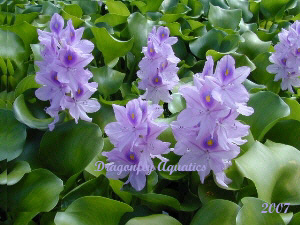
Floating plants such as Water Hyacinth and Water Lettuce are considered tropical and will not survive temperatures below freezing. After the first hard frost, remove from the pond to prevent them from decaying and adding unwanted debris to the pond.
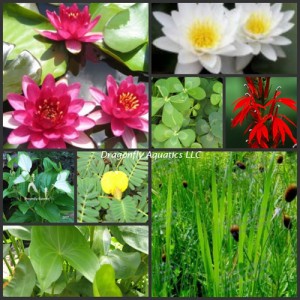 We had highs in the low to mid 80's the last couple of days here in Ohio. One week snow, the next unseasonably warm. Don't want to get too used to it though, next week we will be back to the normal spring time temperatures. Normal here this time of year is mid 50's to mid 60's. Nothing like a few warm days though to get people out working on their ponds. The weather has been on the unusual side. One week snow, the next record breaking high temperatures. It makes it very difficult to know when to ship plants. Many of the plants we sell are cold sensitive and trying to second guess Mother Nature is sometimes impossible! We have customers in the Pacific Northwest that are still freezing, the time has passed when we usually can start to send their plants. Old Man Winter just isn't moving out of that part of the country yet. Hopefully, things will start to warm up for them in the next week or two. And for us in Ohio, we can only hope the milder temperatures will continue. We just want to remind everyone, just because you are having warm temperatures today, does not mean it is safe to put plants out before your last frost date. It has been such a long winter, I know everyone is a little impatient....I am too! But, always remember, Mother Nature likes to throw curve balls at us! Just when we think it is safe to put plants out, along comes a freeze warning!
We had highs in the low to mid 80's the last couple of days here in Ohio. One week snow, the next unseasonably warm. Don't want to get too used to it though, next week we will be back to the normal spring time temperatures. Normal here this time of year is mid 50's to mid 60's. Nothing like a few warm days though to get people out working on their ponds. The weather has been on the unusual side. One week snow, the next record breaking high temperatures. It makes it very difficult to know when to ship plants. Many of the plants we sell are cold sensitive and trying to second guess Mother Nature is sometimes impossible! We have customers in the Pacific Northwest that are still freezing, the time has passed when we usually can start to send their plants. Old Man Winter just isn't moving out of that part of the country yet. Hopefully, things will start to warm up for them in the next week or two. And for us in Ohio, we can only hope the milder temperatures will continue. We just want to remind everyone, just because you are having warm temperatures today, does not mean it is safe to put plants out before your last frost date. It has been such a long winter, I know everyone is a little impatient....I am too! But, always remember, Mother Nature likes to throw curve balls at us! Just when we think it is safe to put plants out, along comes a freeze warning!
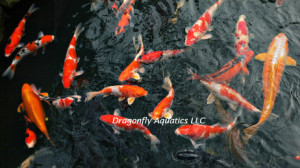 We've checked everything out in our ponds but what about our fish? The fish are swimming and coming to the top of the pond. Don't be in a hurry to feed them. The proper time to begin feeding the fish is when the water temperatures consistently reach at least 50 degrees and above.
We've checked everything out in our ponds but what about our fish? The fish are swimming and coming to the top of the pond. Don't be in a hurry to feed them. The proper time to begin feeding the fish is when the water temperatures consistently reach at least 50 degrees and above.
On the few warmer days of spring they will come to the surface acting as if they want fed. The water should be stabilized around 50 degrees before you resume feeding. You will want to feed them an easily digestible food, such as a wheat-germ-based floating pellet to start with, since their digestive systems are still slow. Microbe-Lift makes a Fall/Spring Fish food that is wheat germ and easily digested. Feed the fish in the morning, feeding them lightly at first so that they will digest their food before the temperature lowers at night for a couple weeks. Once the water temperatures rise above 55 degrees, resume feeding them their normal high-protein food. Any good quality fish food with vitamins will work. Another good choice food for fish is duckweed or azolla. I always put some duckweed in a container in the shade so it grows and multiplies. That way I have it for a treat all summer long. I have heard also that frozen peas are good for fish. I haven't tried that but thinking about it now I will. Just to see if my fish like it.
You may want to add some flake food or balls of cooked oatmeal to your feeding regiment for the baby fish, once they start to appear in early spring.
You will want to make sure your pond water isn't high in ammonia or nitrites for your fish. You can buy test kits to check for this. I always check all the fish for any signs of infection or disease in the early spring so I can treat them before it gets worse. We sell a medicated floating fishfood that works well in treating fish. It is always easier to see the fish in the early spring, before the plants are in the pond.
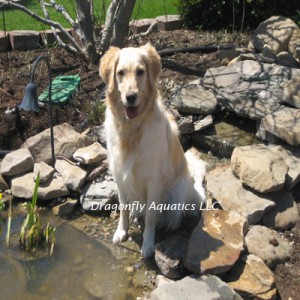 Time to spring forward, or at least turn the clocks forward! Things are beginning to warm up a bit here in the north and we are anxiously waiting for Spring to arrive so we can begin to add new plants to our ponds. Another couple of months and we will be sitting back enjoying our ponds once again. It won't be long now. For those in the warmer regions, zones 8 and above, you are putting pond plants in your ponds and starting to enjoy them, while those of us in the lower zones are still waiting. At least most of the ice has melted and we can begin thinking about our ponds once again.
Time to spring forward, or at least turn the clocks forward! Things are beginning to warm up a bit here in the north and we are anxiously waiting for Spring to arrive so we can begin to add new plants to our ponds. Another couple of months and we will be sitting back enjoying our ponds once again. It won't be long now. For those in the warmer regions, zones 8 and above, you are putting pond plants in your ponds and starting to enjoy them, while those of us in the lower zones are still waiting. At least most of the ice has melted and we can begin thinking about our ponds once again.
Don't be fooled by Mother Nature. We need to make sure it is warm enough outside, and make sure our pond water is warm enough for the plants to survive. Knowing your pond temperature is crucial, so begin by checking your pond water temperature at different times of the day. The pond water is cooler in the morning and warmer in the afternoon but will cool down again in the evening. Knowing what the consistant temperature of your pond water is important before adding the pond plants.
The first plants most of us want to put in are those that will help us keep the pond clear, such as floating plants like water hyacinths and water lettuce. Cold water will kill both of these in a matter of days if the water temperature is still too cold. We need to make sure the water temperature is consistent and reaches 65 degrees and stays there morning, afternoon and evening before we add floating plants.
There are other things we must do first that will keep us busy, such as adding beneficial bacteria to help keep our pond clear. The good bacteria, such as MicrobeLift PL neutralizes ammonia and nitrites, and will start to work when the water temperature are 50-55 degrees. If you add bacteria, it will stay in the pond and start working when the pond water is warm enough. It acts on its own and will stay un-activated until it knows to start working. For those of us who use barley, now is the right time to start adding it. This will also help retard the growth of string algae in the Spring months.
The list goes on and on. While all of us are anxious to add the pond plants there are still several things to do prior to this. I will be posting articles in the next few days with spring tips for our ponds.
Stay tuned!
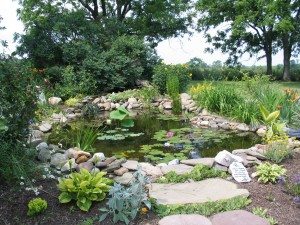 Its essential to achieve a natural ecological balance in your pond. We can achieve this naturally with a few key steps. Adding submerged plants play an important role in achieving success by removing excessive nutrients in the water and provide oxygen during the day for fish and other aquatic creatures. The most important role is removing excessive nutrients that help reduce the incidence of algae which is the nightmare of most water gardeners. They starve out the algae by utilizing all the mineral salts which the algae normally feeds from.
Its essential to achieve a natural ecological balance in your pond. We can achieve this naturally with a few key steps. Adding submerged plants play an important role in achieving success by removing excessive nutrients in the water and provide oxygen during the day for fish and other aquatic creatures. The most important role is removing excessive nutrients that help reduce the incidence of algae which is the nightmare of most water gardeners. They starve out the algae by utilizing all the mineral salts which the algae normally feeds from.
Submerged pond plants oxygenate the water during the day, but at night the process is reversed and carbon dioxide is produced. This only becomes a problem if your night time temperatures are quite warm and you overstock your pond with fish. Generally the more submerged plants you put in your pond the better the pond balance will be.
Algae likes full sunlight so in addition to the submerged plants add floating plants, waterlily foliage or bog plants to cover at least one third to one half of your pond's surface, but no more than one half to be successful in controlling the green suspended algae.
There is a balance to achieve so make sure you don't cover too much of your ponds surface with plants or it will inhibit the submerged plants from growing.
The recommendation is to have 1 bunch of submerged plants per every 2 to 3 square feet of surface area. We sell submerged plants by the bunch so you receive 6-8 plants per bunch. You can determine your surface area by multiplying your length by the width of your pond. This gives you a general idea.
A similar calculation is made to determine the quantity of floating plants and waterlilies for your pond. Determine the square footage and remember you don't want more than half of the surface covered so that the submerged plants receive plenty of light.
Once you create the formula for water clarity the rest is easy.
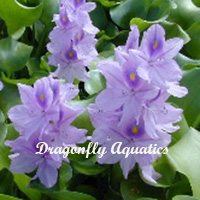 Floating plants such as Water Hyacinth and Water Lettuce are considered tropical and will not survive temperatures below freezing. After the first hard frost, remove them from the pond to prevent them from decaying and adding unwanted debris to the pond.
Floating plants such as Water Hyacinth and Water Lettuce are considered tropical and will not survive temperatures below freezing. After the first hard frost, remove them from the pond to prevent them from decaying and adding unwanted debris to the pond.
Trying to winter them over indoors is difficult. They need to be kept in an aquarium or floated in anything that can hold water. The problem is they lack adequate light intensity. They seem to do well for awhile but by February when they start to grow the natural light is not bright enough to promote proper growth. The water temps need to be at least 70 degrees and they need at least 14 hours of sunlight or equivalent to four fluorescent bulbs held about 12 inches over the water.
When you consider the amount of energy and electricity needed to keep tropical plants alive over the winter its probably cheaper to just use them for mulch in your vegetable garden and buy new ones in the spring.
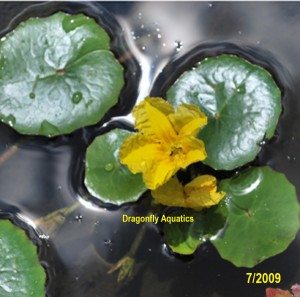 This is a picture of the floating hearts in my pond. The floating heart is a water lily like plant that looks and grows much like a water lily. The miniature size is ideal for small ponds and containers. I planted mine right in my bog area anchored at the rocks edge. It grows freely across the pond water in only a few inches of water.
This is a picture of the floating hearts in my pond. The floating heart is a water lily like plant that looks and grows much like a water lily. The miniature size is ideal for small ponds and containers. I planted mine right in my bog area anchored at the rocks edge. It grows freely across the pond water in only a few inches of water.
This is a hardy plant in Zones 5-11. It is very free-flowering and a fast grower with a running spread. It ideally grows in 4-24 inches of water. The leaves are slightly toothed and an even green, sometimes showing a hint of brown throughout the leaves. It will bloom throughout the growing season with little to no care.
You can find floating hearts here.